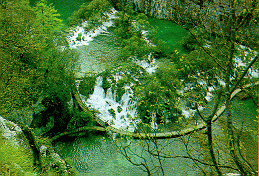


Unesco s particulary interested in preserving
exceptional natural sites all over the world. In
eastern parts of Lika, at the point of contact
between the mountains of Mala Kapela and Licka Pljesivica,
there is a series of differently sized lakes, 16 in total,
cover ng the surface of about 2 sq. km. The difference in
altitude betwern the first and the last one amounts to 134
m, whereas the largest amons them - the lake of Kozjak
(0.8 sq kmJ is also the deepest one (46 m) The Plitvice
Lakes are among the most beautiful examples of our karst
hydrography. The water, rich in limestone, forms sediments
in appropriate spots, and, with the he p of bacteria, algae
and moss, creates abundantly spread and "live' waterfalls
that grow and change shape almost before our very eyes
By doing so, in time, they also change the lakes' size and
shape We know today that the existing waterfal s are no
older than 4,000 years. Back in 1914, with the appearance
of the first national parks in Europe, occurred also the
initial proposals to !ist Plitvice lakes among them. However,
this was not done unti 1949 Thirty years after, Plitvice
Lakes were among the first in Europe to be inscribed by
UNESCO on the World Heritage List. In 1992, they also
appeared on the list of the World Heritage in Danger. The
Plitvice Lakes Nationa Park area encompasses 200 sq. km